The Canucks A Photo History Of Vancouver's Team
The Polygon Gallery presents The Canucks: A Photo History of Vancouver’s Team, a series of photographs looking back on the history of the Vancouver Canucks. These rare photos span decades, beginning in the 1950s and ’60s when the Canucks played in the Western Hockey League, through the team’s franchising with the National Hockey League from 1970 onward.
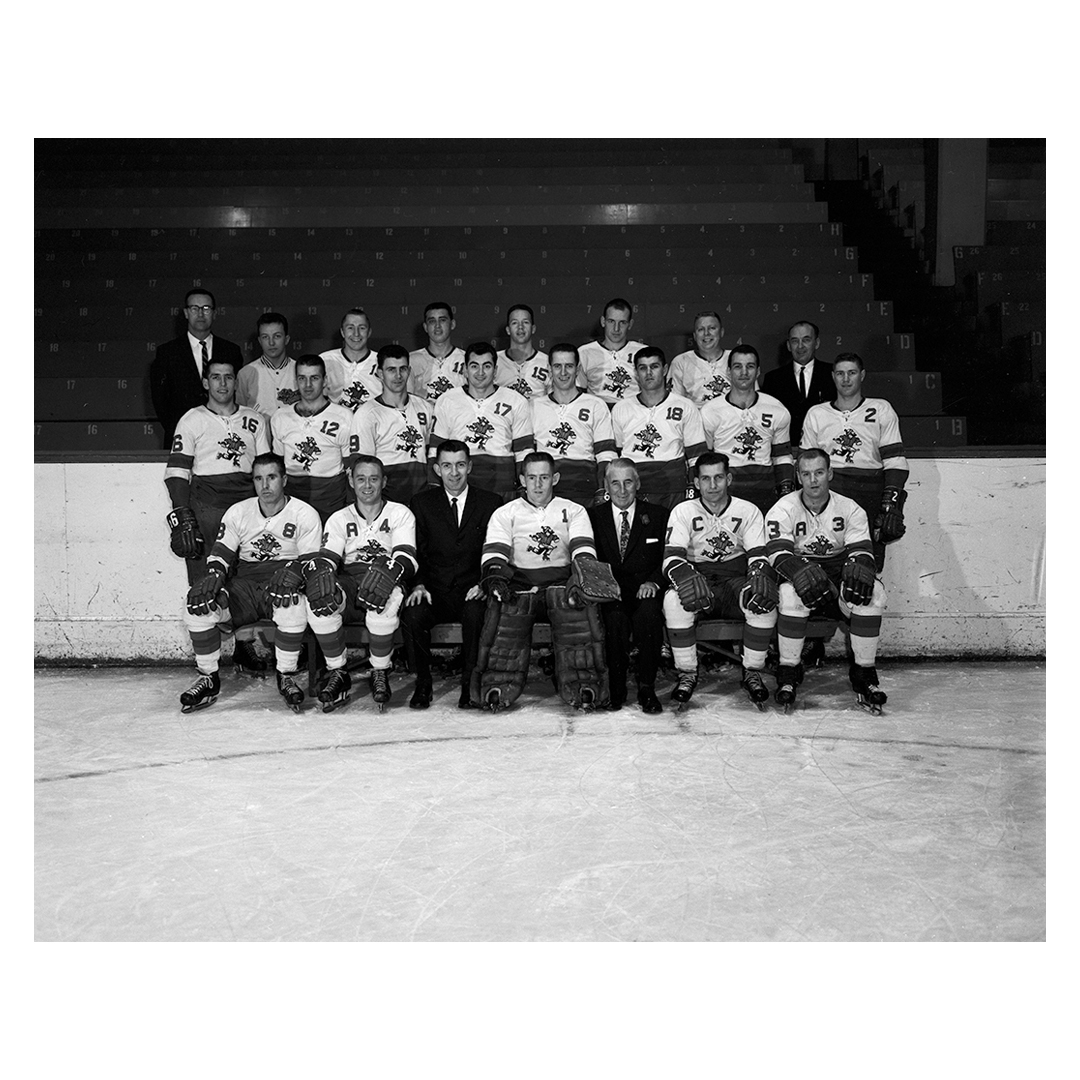
Team photo of the 1963 WHL Canucks with coach Max McNab.
John McGinnis/Vancouver News-Herald
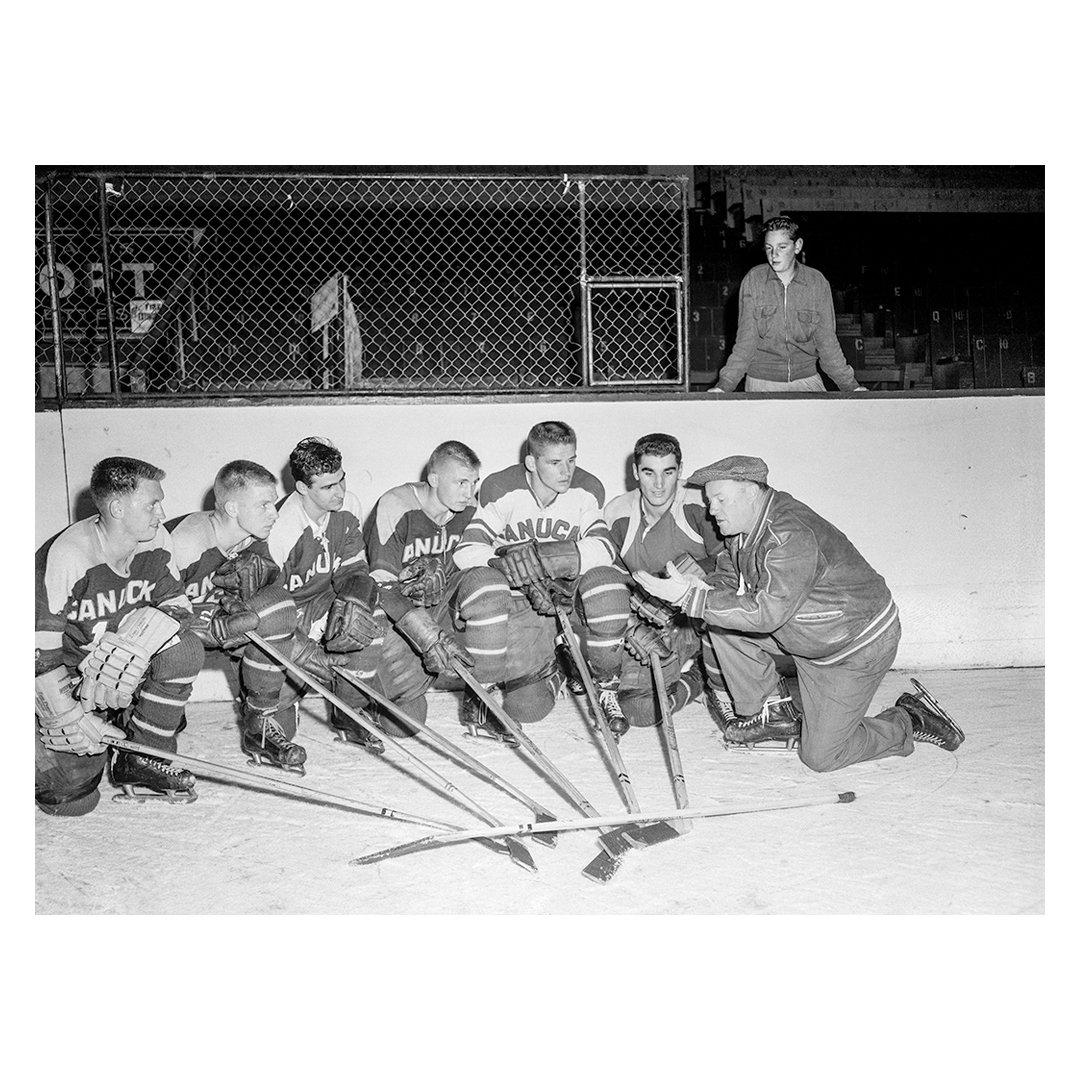
The 1963 WHL Canucks with head coach Max McNab, no. 8 Phil Maloney, no. 1 goalie Gilles Villemure, no. 2 Adam Keller, no. 3 Les Hunt, no. 12 Ron Hutchinson, no. 17 Marty Howe, no. 15 Howie Hughes, no. 18 Robert Kabel, no. 5 Al Lebrun, no. 6 Bob McCusker, and no. 16 Trent Beatty.
John McGinnis/Vancouver News-Herald

WHL Canuck no. 8 Phil Mahoney and Victoria Shamrocks goalie Marcel Pelletier.
John McGinnis/Vancouver News-Herald

Legendary Vancouver weightlifter and professional wrestler Doug Hepburn performs a feat of strength—lifting up a platform with six Vancouver Canucks hockey players using his back. Oct. 2, 1954.
Roy LeBlanc/Vancouver Sun
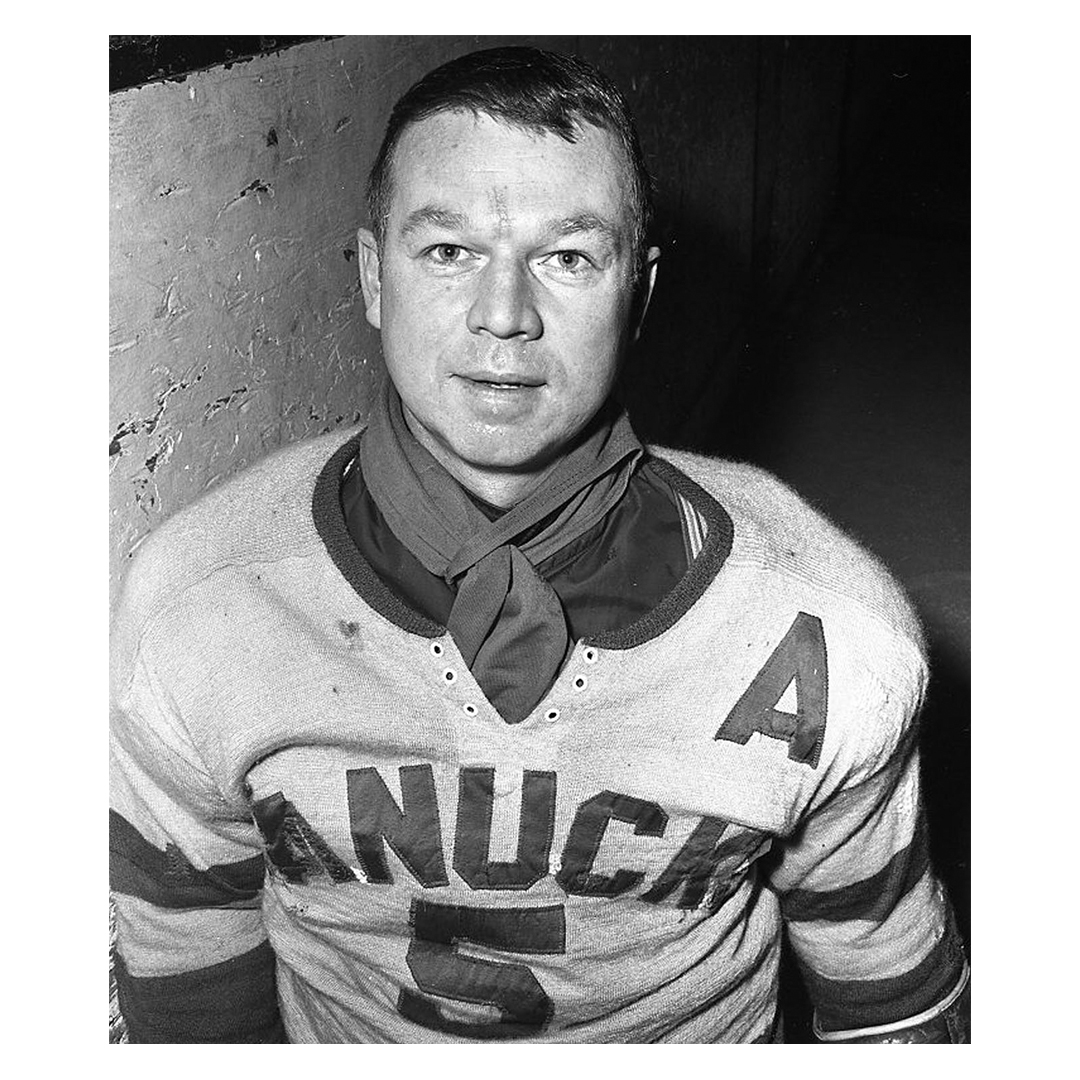
WHL Vancouver Canucks no. 5 Don Cherry. Cherry played for the Canucks during the 1968-69 season. The team won the WHL championship trophy, the Lester Patrick Cup, that season.
Ralph Bower/Vancouver Sun
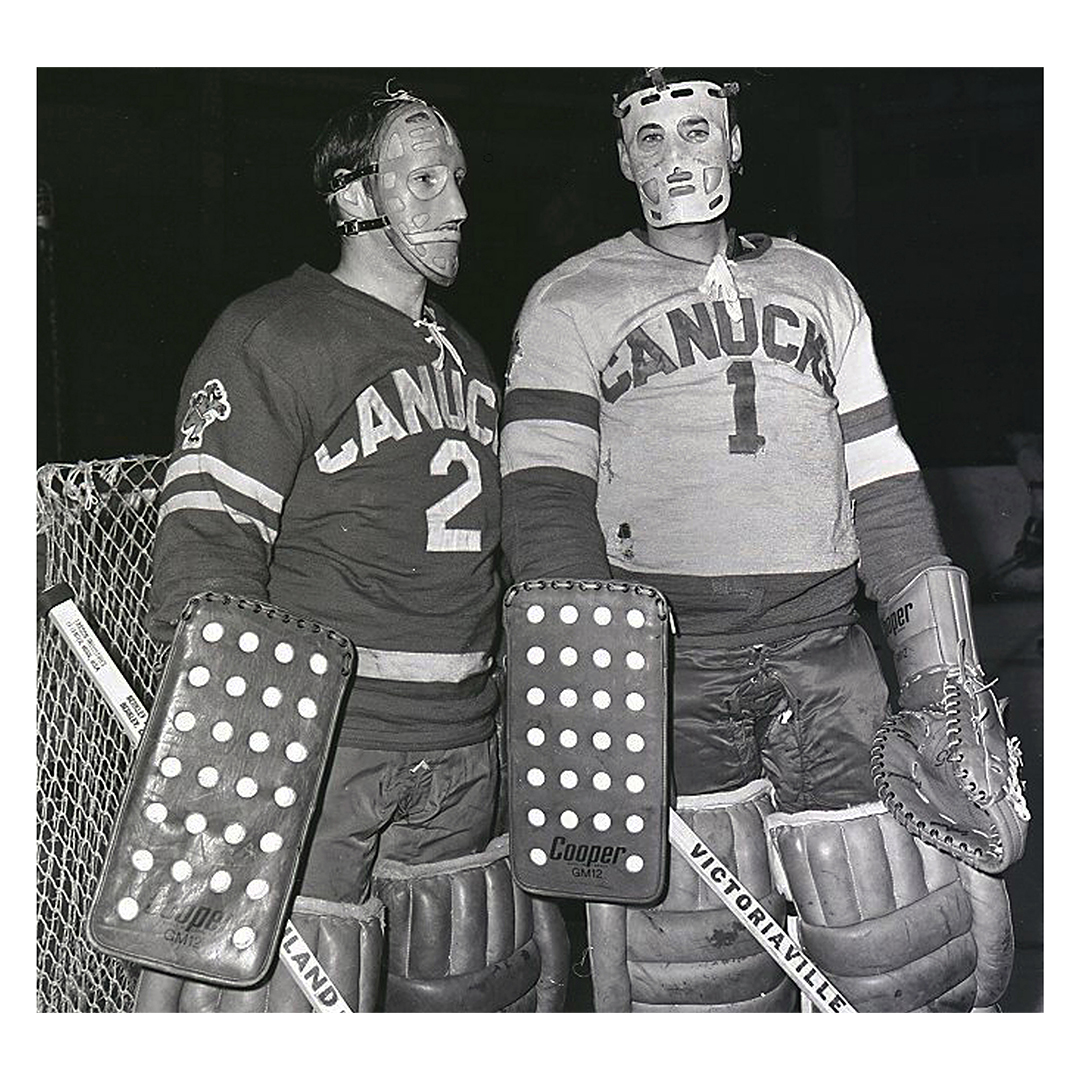
WHL Canuck goalies no. 1 George Gardner and no. 2 Charlie Hodge during the 1968-69 season. Both went on to play for the NHL Canucks in 1970.
Ralph Bower/Vancouver Sun

WHL Canucks goalie George Gardner in practise in the late 1960s. George was in goal for the WHL Canucks in 1968-70 seasons and was the first goalie for the new 1970 NHL Canucks.
Ralph Bower/Vancouver Sun

Vancouver Canucks goalie George Gardner found the temperature cold at Canucks practices, so donned a hockey sock as a toque. Gardner is wearing an old-school goalie mask. Gardner played for the WHL Canucks in 1968-70, then spent two seasons with the NHL Canucks in 1970-72. Nov. 1, 1968.
Bill Cunningham/The Province

Vancouver Canucks goalie George Gardner hockey card.

WHL Canuck owner Coley Hall with some of the 1946 Canucks players, left to right: Harvey Ross, Ab McDougall, Hall, and Chuck Millman. Oct. 8, 1946.
Vancouver Sun

Colman (Coley) Hall was regarded as the founding father of the Canucks. He was owner and president of the WHL Canucks, naming the team after a wartime comic-book character Johnny Canuck. In 1959, Mr. Hall sold the WHL Canucks to Pacific National Exhibition. He was then an advisor to a Vancouver group that was unsuccessful in landing an NHL expansion franchise for the 1967-68 season. He eventually worked for Medicor, the US-based company that landed the franchise for the 1970 Vancouver NHL team. Mr. Hall quietly managed the business side of the NHL Canucks as majority owner; Tom Scallen dealt with fraud charges that eventually would land him in jail. Mr. Hall then brokered a deal for the sale of the team to broadcaster Frank Griffiths for $8.5 million.
Bill Cunningham/The Province

Coley Hall, president of the NHL Canucks, comparing his physique to Dennis Ververgaert, the team’s 1973 draft pick, 1973. “Coley said, ‘You guys aren’t as tough as we used to be,’ and took his shirt off to match him at the press conference.” Coley was 67 at the time, Ververgaert was 20. But their physiques were similar—and Coley Hall was a renowned tough guy.
Ralph Bower/Vancouver Sun

1965 WHL Canucks goalie Gilles Villemure against the Hershey Bears, with Canucks no. 5 Larry Cahan and no. 7 Larry Popein.
Ralph Bower/Vancouver Sun

Willie O’Ree, the 1st black player in WHL. He scores for the visiting LA Blades while checked by Canucks no. 9 at the PNE Forum in the late ’60s.
Ralph Bower/Vancouver Sun

Canucks rookie and 1969 WHL Most Valuable Player Gump Worsley vs NY Ranger Vic Hadfield. Later Worsley played his best years for the Montreal Canadiens as a member of four Stanley Cup-winning teams: 1965, 1966, 1968 and 1969.
Ralph Bower/Vancouver Sun

One of the most popular players with the Canucks in the early years, no. 8 Phil Maloney vs WHL Seattle Totems in the late ’60s. Maloney is considered the heart and soul of the Vancouver Canucks during their WHL era. He spent 14 years with the Vancouver Canucks in the Western Hockey League (WHL) and was the career scoring leader for the franchise with 923 points in 818 games. He was one of the best WHL players ever, Maloney one scored eight points in a single game. Twice named as the WHL’s most valuable player and in 1958 he led the Canucks to the WHL Championship and the Lester Patrick Trophy. He also played on the 1969 Canucks when they won the WHL championship. He retired as a player at the end of the 1969-70 season, the year before the Canucks became a part of the NHL.
Phil Maloney made his home in the Vancouver Island community of Yellow Point and died at the age of 92 on February 21, 2020
Ralph Bower/Vancouver Sun

Phil (Fox) Maloney hockey card, coaching the NHL Canucks. Maloney was prominent on the hockey scene in Vancouver, serving first as a scout and for parts of four seasons as the NHL Canucks coach. Under Maloney’s guidance as coach and GM from 1974-77, the Canucks made the Stanley Cup playoffs twice, including a division title in 1974-75, his first full year as coach. He coached 232 games with the franchise. In 1976, he fired himself following a 5-4 loss to the Montreal Canadiens. He handed the reins over to Orland Kurtenbach.
1974-75 O-Pee-Chee #104 card

WHL Canucks star Andy Bathgate and teammates celebrating after winning the WHL Championship over Portland Buckaroos, 1969.
Ralph Bower/Vancouver Sun

WHL Canuck Andy Bathgate being honored in 1969, the year the team won the Lester Patrick Cup. Later Bathgate played 17 seasons in the NHL and in 2017 Bathgate was named one of the “100 Greatest NHL Players In History”.
He is famous for contributing to one of the greatest innovations in the NHL. Renowned for the strength of his slap shot, during a game on November 1, 1959 against the Montreal Canadiens, Bathgate shot the puck into the face of Jacques Plante, forcing Plante to receive stitches. When Plante returned to the ice, he was wearing a mask. That started a trend that continues to this day.
Ralph Bower/Vancouver Sun
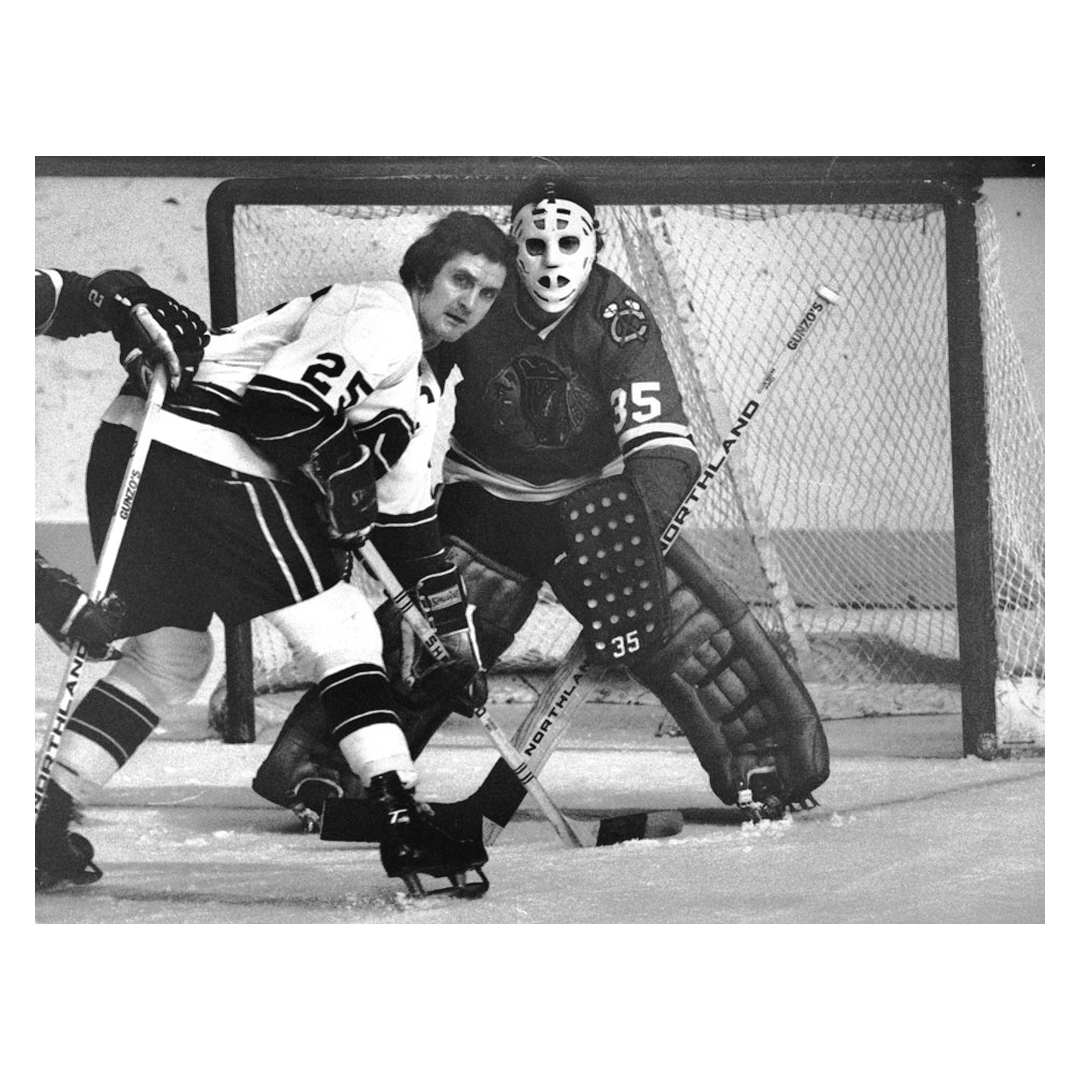
Orland Kurtenbach, the first centre with the 1970 Canucks, in front of Chicago Blackhawks star goalie Tony Esposito, 1970. (All-star Tony Esposito turned pro with the WHL Vancouver Canucks in the 1967–68 season.)
Ralph Bower/Vancouver Sun

The first captain of the NHL Canucks, Orland Kurtenbach, in 1970. He retired from playing in 1974 and was the team’s head coach from 1976-78.
Deni Eagland/Vancouver Sun

The Stanley Cup at the opening ceremony of the first game of the NHL Canucks on October 9th, 1970. They played host to the Los Angeles Kings at the Pacific Coliseum.
Ralph Bower/Vancouver Sun

Celebrating the first goal by the new NHL 1970 Vancouver Canucks team. The goal was scored by no. 4 Barry Wilkins, seen celebrating with no. 2 Gary Doak, no. 7 André Boudrias, and no. 19 Dale Tallon. Oct. 9, 1970.
Ralph Bower/Vancouver Sun

No. 3 Defenseman Pat Quinn vs LA Kings, 1970. Pat (The Big Irishman) Quinn played two seasons for the Canucks. He became President and General Manager of the Canucks in 1987-88 and then was head coach from 1991-94, taking the Canucks to the Stanley Cup final in 1993-94. Following the Stanley Cup appearance, Quinn gave up his coaching duties to focus on his roles as President and General Manager.
Ralph Bower/Vancouver Sun

Canuck Charlie Hodge saves a goal from California Seals Ernie Hicke. Ralph Bower was the first photographer to mount a camera with a 20mm lens in the net. December 13, 1970.
Ralph Bower/Vancouver Sun

The second time Ralph Bower placed his camera in the Canucks’ goal, capturing goalie George Gardner and no. 12 Mike Corrigan in action, 1970.
Ralph Bower/Vancouver Sun

Camera reveals the snowy aftermath of a goal against Dunc Wilson. Bower was ‘shooting blind’ and only later in the darkroom he saw what he had captured. Dec. 1971.
Ralph Bower/Vancouver Sun

Ralph Bower’s plywood box that he placed in the goal net. Ralph Bower was the first sports photographer to put a camera in the goal tenders net. He had to negotiate with the league, the Canucks coach and the goalies for permission.
A Vancouver Sun carpenter constructed this box to hold his 35mm camera with a 20mm wide lens. The box has a hinge at its base, so it could be knocked over if the goal-tender fell into the net.
To snap the shutter, Bower had a wire implanted in the ice leading to a spot in the stands behind the Canucks net. He could snap a photo by pressing an electric doorbell attached to the wire. He was able to place the box into the net 4 times. A first attempt was thwarted when the Zamboni ice-cleaning machine severed the wire in the ice. The next two times he got the three photos shown in this post. The last time ‘King’ Richard Brodeur knocked over the box.

Canucks first superstar no. 15 Rosaire (Cracklin’ Rosie) Paiement watches Rangers defenseman no. 15 Jim Neilson glove away an almost certain goal while no. 30 goalie Gilles Villemure looks for the puck. Feb. 7, 1971.
Ralph Bower/Vancouver Sun

Canucks center Rosie Paiement scored 34 in 1971 but had only scored only one in 1972. After a 33-game scoring drought, Reveen the Impossiblist hypnotises Paiement to break the jinx. Unfortunately he went another 5 games scoreless, finally scoring against the Boston Bruins—but the Canucks lost 9-1. 1972.
Dan Scott/Vancouver Sun

‘Doak holds the Hottest Stick in the Land’. No. 2 Canuck Gary Doak holding Boston Bruins high scorer Phil Esposito’s stick, March 1971.
Ralph Bower

Canucks centre no. 20 Bobby LaLonde scores on famous Montreal Canadien goalie Ken Dryden, 1971.
Ralph Bower

Canucks goalie Gary (Suitcase) Smith meets speedy no. 10 Guy Lafleur of the Montreal Canadiens, 1974.
Ralph Bower

Tom Scallen, American businessman and the first owner of the NHL Canucks, seen leaving the Vancouver courthouse, escorted by the RCMP to Oakalla prison. He was charged with theft and issuing a false prospectus. A jury found him guilty in the spring of 1973. He appealed (Vancouver entrepreneur Jim Pattison guaranteed his bail) but lost and spent a month in a prison hospital with a broken leg before being sent to minimum security. He was ordered to do white-collar work behind bars, documenting and submitting the jail’s food orders. After serving nine months of a two-year sentence, he was released and deported. Scallen was pardoned in 1982. March 30, 1974.
Ralph Bower/Vancouver Sun

Canuck fans flood on to the ice after the Canucks win the WHL league cup over the Portland Buckaroos in 1969.
Ralph Bower/Vancouver Sun

Fans welcome the Canucks home on May 12, 1982, after they lost the first two games of the Stanley Cup Final against the New York Islanders. The Canucks went on to lose the Stanley Cup Final series 4–0.
Dan Scott/Vancouver Sun

The parade in downtown Vancouver after 1982 run to the Stanley Cup – Canucks Ron Delorme and ‘King’ Richard Brodeur are surround by fans.
Ralph Bower/Vancouver Sun 
Vancouver Canucks fans go crazy after their team scores against the Calgary Flames during the second period of Game 1 of the Western Conference’s Pacific Division 2015 Stanley Cup playoff match up at Rogers Arena. April 15, 2015.
Ric Ernst/The Province

The Russian Rocket Pavel Bure, making his debut with the Vancouver Canucks. Nov. 5, 1991.
His first practice with the club on November 3, 1991, was attended by approximately 2,000 fans. In his first season he won the Calder Memorial Trophy as the league’s best rookie and led the NHL in goal-scoring in 1993-94, helping the Canucks to the 1994 Stanley Cup Finals. During his time with the Canucks, Bure won the team’s Most Exciting Player Award, as voted by the fans, a record five times, from 1992 to 1995, and once more in 1998. Bure is statistically among the top players in NHL history.
Ralph Bower/Vancouver Sun

Vancouver Canucks player Pavel Bure, the “Russian Rocket”, arrives at the airport, welcomed by hundreds of fans during the Stanley Cup playoffs. June 3, 1994.
Jeff Vinnick/Vancouver Sun

PAVEL’S FEELING THE PINCH – Canucks superstar Pavel Bure gets a physical test from Dr. Ted Rhodes. Ralph Bower happened upon the scene by chance when he was standing outside the Centre Ice Restaurant at the Coliseum and saw Bure being brought in. Even though the Canucks management reprimanded Bower for the bare chest picture, the photo was a huge hit when it ran on the front page of the Vancouver Sun and more than 4,000 extra copies were sold that day. Sept. 1994.
Ralph Bower/Vancouver Sun

Buddies Gino Odjick and Pavel Bure chat during Thursday morning Canucks training session in Whistler. Sept. 12, 1996.
Bonny Makarewicz / The Province

Vancouver Canucks favorites Gino Odjick, Pavel Bure and Mattias Ohlund ride the team bus to Whistler for the first day of training camp. Sept. 1997.
Mark van Manen/Vancouver Sun

Pat Quinn played nine NHL seasons, including 1970-72 with the Canucks. He had two stints as Vancouver Canucks coach, first from 1991 to 1994 and (very briefly) in 1996 and coached Canada’s junior and Olympic teams, 1993
Ian Smith/Vancouver Sun

Pat Quinn reflects on Canuck’s hockey season at GM Place. 2013
Glenn Baglo/Vancouver Sun

The 1994 Canucks are joined by their coach Pat Quinn on the red carpet prior to the 2014 Tim Hortons NHL Heritage Classic at BC Place Stadium, March 2014. The 1994 team went to the Stanley Cup final against the NY Rangers, losing in game 7.
Ric Ernst/The Province

A statue of Pat Quinn was unveiled by the Vancouver Canucks, with Trevor Linden, Canucks president of hockey operations, and former players Jyrki Lumme and Dave Babych, Feb. 2017.
Ralph Bower/ Vancouver Sun